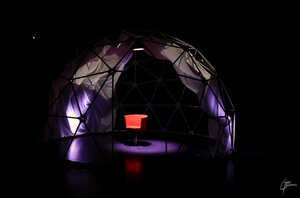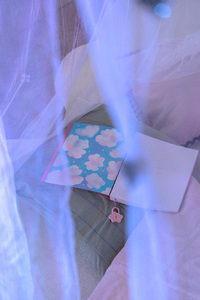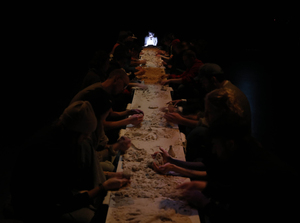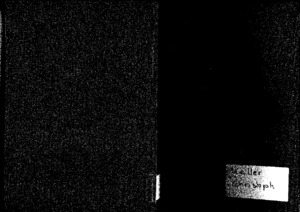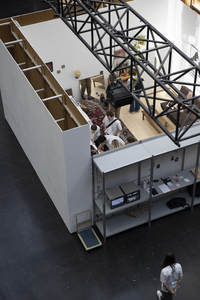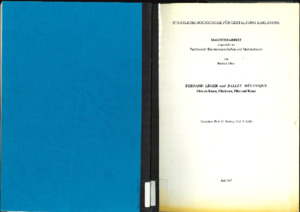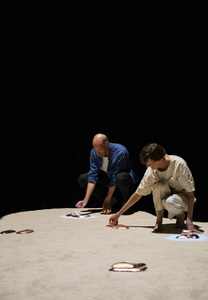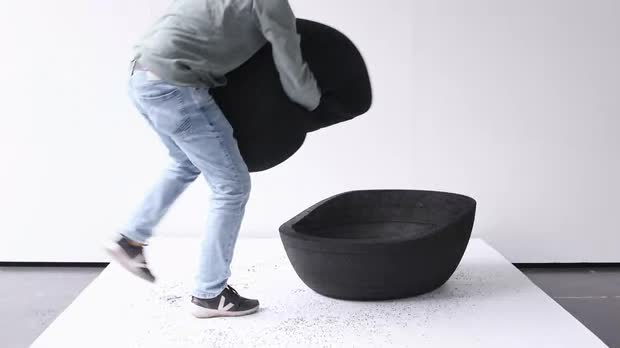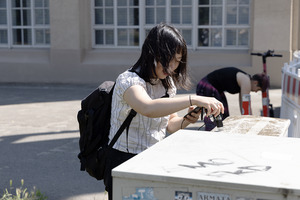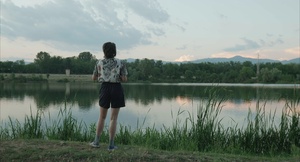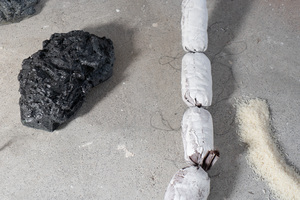Eine Neue Umwelt
Benachbarte Sets (112)Alle Zusammenhänge anzeigen
Diese Sets wurden den gleichen Sets hinzugefügt wie das ausgewählte Set.
112 Inhalte
- Seite 1 von 10
Erikas Töchter
- Titel
- Erikas Töchter
- Autor/in
- Beschreibung (de)
- "Erikas Töchter" untersucht anhand der fiktiven Figur Erika Mustermann Perspektiven auf die deutsche, weibliche* Identitätsbildung in Deutschland. Seit 1987 existiert Erika als Musteridentität in amtlichen Dokumenten – weiß, blond, blau- oder grünäugig. Als ein lächelnder Anachronismus geistert sie, erschreckend unkommentiert, durch die Bürokratielandschaft Deutschlands.
Die Arbeit übersetzt diese fiktive Identität in ein irritierendes Szenario, das zwischen Gartenfest, Ausstellung, Performance und Büroalltag changiert. Im Zentrum stehen zwei Ebenen: Zum einen die Präsentation der IDOLLs, einer Serie neuer weiblicher Musteridentitäten, die im Format einer Teleshopping-Show als innovative Lösung zeitgenössischer Identitätsprobleme vermarktet werden. Zum anderen der Blick in Erikas Büroalltag. Umgeben von Plastik-Buchsbaumbüschen, Teppichboden und generischen Büromöbeln ist sie gefangen im Moment des Fotos und der Reproduktion ihres Gesichtes.
Erikas durchdringende Augen blicken uns alle aufmerksam an, die Mundwinkel deuten ein neutrales Lächeln an. Doch je länger man sie betrachtet, desto schwerer wiegt ihr Blick: normierend, klassifizierend und ausschließend. Ihre Stimme, körperlos und fragmentarisch, erzählt aus dem Inneren dieses leeren Gesichtes und stellt die Frage, welche Gesichter und Narrative durch sie aus dem kollektiven Bild verschwinden.
- "Erikas Töchter" untersucht anhand der fiktiven Figur Erika Mustermann Perspektiven auf die deutsche, weibliche* Identitätsbildung in Deutschland. Seit 1987 existiert Erika als Musteridentität in amtlichen Dokumenten – weiß, blond, blau- oder grünäugig. Als ein lächelnder Anachronismus geistert sie, erschreckend unkommentiert, durch die Bürokratielandschaft Deutschlands.
- Beschreibung (en)
- “Erikas Töchter” explores perspectives on german, female* identity formation in Germany through the fictional figure of Erika Mustermann. Since 1987, Erika has served as the standard identity in official documents – white, blonde, blue- or green-eyed. As a smiling anachronism, she continues to haunt Germany’s bureaucratic landscape.
The work translates this fictional identity into a scenario that shifts between garden party, exhibition, performance, and office routine. At its center are two layers: on the one hand, the presentation of the IDOLLs – a series of new female standard identities, presented in the style of a teleshoppingshow, offering an innovative approach to contemporary issues of identity; on the other hand, a glimpse into Erika’s everyday office life. Surrounded by plastic boxwood shrubs, carpeting, and generic office furniture, she remains trapped in the moment of the photograph and the endless reproduction of her own face.
Erika’s eyes look directly at the viewer, the corners of her mouth suggesting a neutral smile. Yet the longer she gazes at you, the more insistent her expression becomes: classifying and excluding. A bodiless, fragmentary voice accompanies the scene, offering insights from within this empty face and raising the question of which faces and narratives disappear from the collective image through her.
- “Erikas Töchter” explores perspectives on german, female* identity formation in Germany through the fictional figure of Erika Mustermann. Since 1987, Erika has served as the standard identity in official documents – white, blonde, blue- or green-eyed. As a smiling anachronism, she continues to haunt Germany’s bureaucratic landscape.
- Kategorie
- Typ des Projekts/Werks
- Schlagworte
- Datierung
- 22.07.2025
- Mitwirkende
- Sprache
- Material
- Abmessungen
- Ein kleines Haus mit Garten
- Dauer
- 4 Stunden
- Ort: Institution
- Stadt
- Land
- Titel
- Erikas Töchter
- Projektleiter/in
- Semester
- Studiengang
- Typ der Abschlussarbeit
- Importiert am
- 29.09.2025
- Übergeordnete Sets
- 0
- Set enthält
- 2 0
ERLEBNIS THEATER
- Titel
- ERLEBNIS THEATER
- Untertitel
- Für eine wahrnehmungszentrierte Raumtheorie im Theater
- Untertitel des Projekts/Werks (en)
- For a perception-centered theory of space in the theater
- Autor/in
- Beschreibung (de)
- Das Projekt behandelt die sensitive Wahrnehmung in Räumen und kritisiert dessen Nicht-Vorhandensein speziell in Theater-Architekturen.
- Beschreibung (en)
- The project deals with sensitive perception in spaces and criticizes its non-existence, especially in theater architecture.
- Kategorie
- Schlagworte
- Datierung
- Mai 2021
- Mitwirkende
- Ort: Institution
- Ort
- Großes Studio
- Stadt
- Land
- Internetlinks
- Titel
- ERLEBNIS THEATER
- Projektleiter/in
- Semester
- Studiengang
- Typ der Abschlussarbeit
- Importiert am
- 14.06.2024
- Übergeordnete Sets
- 2
- Set enthält
- 0 11
eternal girlhood
- Titel
- eternal girlhood
- Untertitel
- oh my dreams
- Autor/in
- Beschreibung (de)
- “eternal girlhood” ist eine konzeptionelle Arbeit, welche aus einer Rauminstallation und einer Publikation besteht.
Ursprünglich in den Chinesischen Pavillons des Fasanengartens in Karlsruhe installiert, wurde der Raum mit der Handlung der Publikation durch Requisiten sowie ein selbst produziertes Musikstück verknüpft.
Das Projekt ermöglicht eine Reise in eine poetische Geschichte, inspiriert von persönlichen und kulturellen Themen wie Girlhood, Coming-of-Age und Growing Pains.
Die handgebundene Publikation mit glitzerndem und geprägtem Umschlag umfasst auf ca. 100 Seiten neben Serien analoger Schwarzweiß-Fotografie farbige Mittelformat-Fotos, begleitet von analogen Schnappschüssen und Illustrationen im Riso-Druck.
Zwischen Fotoserien und Illustrationen sind Songtexte sowie Skriptfragmente und Gedichte eingestreut, in Referenz zu Filmsequenzen aus Coming-of-Age-Geschichten. Es ergibt sich die zeitlose Skizze eines Mädchens, das Teil einer innig verbundenen Mädchengruppe ist.
Transparente Drucke von drei Mittelformat-Fotografien werden vom Fensterlicht erleuchtet und symbolisieren in Zusammenhang mit dem Buch unterschiedliche Kapitel der Geschichte.
Unter einem Baldachin, umgeben von funkelnd tanzenden Schmetterlingen, können Besucher*innen in diese Welt eintauchen und sind eingeladen, für einen Moment Teil von „eternal girlhood“ zu sein, fernab der Echtzeit.
- “eternal girlhood” ist eine konzeptionelle Arbeit, welche aus einer Rauminstallation und einer Publikation besteht.
- Beschreibung (en)
- “eternal girlhood“ is a conceptional artwork, blending a publication with its installation space.
Initially installed in the Chinese pavillons of the Fasanengarten in Karlsruhe, the space was connected to the story of the book through props and a musical sound score.
The project offers a journey into a poetic story, inspired by personal and cultural ideas on girlhood, coming of age and growing pains.
Handbound, wrapped in a glittery embossed dustcover, the publication features around 100 pages with multiple series of black and white film photography, medium format shots underlined by analog snapshots and Riso printed Illustrations. In between the chapters of photography and Illustrations, lyrics, fragments of script and poems are inserted in reference to movie sequences from coming of age stories. A timeless profile of a girl being part of girlhood and a deeply connected friendship is created.
Transparent prints of three medium format photos are illuminated by the windows’ natural light and symbolize different chapters of the story in combination with the book.
Underneath a canopy, surrounded by sparkling dancing butterflies, visitors can dive into this world and are invited to become part of “eternal girlhood“, away from modern reality.
- “eternal girlhood“ is a conceptional artwork, blending a publication with its installation space.
- Kategorie
- Typ des Projekts/Werks
- Schlagworte
- Datierung
- 05.07.2024
- Mitwirkende
- Dank an
- Sprache
- Material
- Technik/Verfahren/Formate
- Risographie, Digitaldruck, Mediumformat-Fotografie, Schreibmaschine, Laser, Prägung
- Abmessungen
- Fläche: ca. 5m x 5m, Höhe der Aufhängung ca. 3m
- Ort: Institution
- Ort
- Chinesische Pavilions des Fasanengarten
- Stadt
- Land
- Beteiligte Institution(en)
- Titel
- eternal girlhood
- Projektleiter/in
- Semester
- Studiengang
- Typ der Abschlussarbeit
- Importiert am
- 05.11.2024
- Übergeordnete Sets
- 3
- Set enthält
- 0 21
Etwas Aufnehmen
- Titel
- Etwas Aufnehmen
- Titel (en)
- Get in touch with
- Untertitel
- Eine Reading Performance in 4 Teilen
- Untertitel des Projekts/Werks (en)
- A reading performance in 4 chapters
- Autor/in
- Beschreibung (de)
- "Etwas Aufnehmen" ist eine 30-minütige interaktive Reading Performance über den (Tast-) Sinn. Sie findet an einem 15 m langen Steintisch statt, 80 kg kinetischer Sand liegen auf ihm verteilt. Die Performance entstand in sechsmonatiger Recherche und im Austausch mit einer blinden Künstlerin, einem Tastforscher, einem Übersetzer von visuellen Lernmaterialien und einer Tierkommunikationsexpertin und erzählt außerdem von einer Kollaboration mit einem Hund (Betty). Welchen Stellenwert nimmt der Tastsinn in unserer Wahrnehmung ein, um Dinge wortwörtlich zu "begreifen"? Wie kommuniziere oder gestalte ich mit einem Tier, welches auf ganz andere Sinne zurückgreifen kann? "Etwas Aufnehmen" hinterfragt die eigene Wahrnehmung und beschreibt den Drang nach Verständigung. Die Reading Performance ist sowohl taktil, auditiv als auch visuell wahrnehmbar.
- Beschreibung (en)
- "Get in touch with" is a 30-minute interactive reading performance about the (tactile) sense. It takes place on a 15 metre long stone table with 80 kg of kinetic sand on top. The performance is the result of a six-month research and exchange with a blind artist, a tactile researcher, a translator of visual learning materials and an animal communication expert, and also tells of a collaboration with a dog (Betty). What role does the sense of touch play in our perception? How do I communicate or design with an animal that has access to completely different senses? "Etwas Aufnehmen" questions our own perception and describes the urge for understanding. The reading performance can be experienced tactilely, acoustically and visually.
- Kategorie
- Typ des Projekts/Werks
- Schlagworte
- Datierung
- Februar 2023
- Mitwirkende
- Dank an
- Sprache
- Untertitel (Film)
- Material
- Abmessungen
- Länge: 15m, Breite: 25cm, Höhe: 25cm
- Dauer
- 30min
- Ort: Institution
- Ort
- Großes Studio
- Stadt
- Land
- Internetlinks
- Titel
- Etwas Aufnehmen
- Projektleiter/in
- Semester
- Studiengang
- Typ der Abschlussarbeit
- Importiert am
- 05.10.2024
- Übergeordnete Sets
- 2
- Set enthält
- 0 16
Excreta Fluxorum - Theatrum Instrumentorum
- Titel
- Excreta Fluxorum - Theatrum Instrumentorum
- Untertitel
- George Maciunas und die Kultur der „curiositas”
- Autor/in
- Beschreibung (de)
- „Möglicherweise erscheinen die intermediären Kunstformen der 60er-jahre als zu komplex, ihre Manifestationen zu sehr als Teil einer noch lebenden Kunstgeschichte, vielleicht hindert auch die noch nicht abgeschlossene Bewältigung der postmodernen Wende in Philosophie, Kunst und Literatur an einer generalüberholten wissenschaftlichen Annäherung an diesen Themenbereich, der sich von der fließenden, aus Künstlerkommentaren über Kritiken in methodischen Darstellungen hervorgegangenen bisherigen Versuchen einer vorläufigen Einordnung des Phänomens Fluxus abzugrenzen hätte."
- Beschreibung (en)
- “It is possible that the intermediary art forms of the 1960s appear too complex, their manifestations too much a part of a still living art history; perhaps the fact that the postmodern turn in philosophy, art and literature has not yet been completed also prevents a generally overhauled academic approach to this subject area, which would have to distinguish itself from the fluid attempts at a provisional classification of the phenomenon of Fluxus that have emerged from artists' commentaries on critiques in methodical presentations.”
- Kategorie
- Typ des Projekts/Werks
- Schlagworte
- Datierung
- 04.03.1999
- Sprache
- Ort: Institution
- Stadt
- Land
- Titel
- Excreta Fluxorum - Theatrum Instrumentorum
- Projektleiter/in
- Semester
- Studiengang
- Typ der Abschlussarbeit
- Archiv-Signatur
- HfG HS 1999 01
- Externes Archiv
- Importiert am
- 11.01.2024
- Übergeordnete Sets
- 2
- Set enthält
- 0 3
existence.exe
- Titel
- existence.exe
- Titel (en)
- existence.exe
- Autor/in
- Beschreibung (de)
- Das Konzept der „Selbstoptimierung“ hat eine zunehmende gesellschaftliche Relevanz erreicht, dementsprechend haben zahlreiche Apps, die sich auf den Körper, die Emotionen und das Selbstmanagement konzentrieren, nach und nach mein Leben durchdrungen.
Ich scheine gleichzeitig in zwei Formen zu existieren: einerseits als organisches Wesen, das aus Wahrnehmung, Widersprüchen und zufälligen Erfahrungen besteht; andererseits als digitales Modell, das von verschiedenen Anwendungen konstruiert wurde.
Allmählich gewöhnte ich mich daran, mich selbst über Zahlen zu messen und zu analysieren – von der Kalorienaufnahme über Schlafzyklen bis hin zu feinen Schwankungen der Herzfrequenz – doch dabei verlor ich zunehmend das Vertrauen in die natürliche Wahrnehmung meines Körpers.
Diese Programme geben vor, „personalisierte Dienste“ zu sein, verwandeln uns letztlich aber in ein einheitliches Datenformat, das sich bequem kategorisieren, vergleichen und extrahieren lässt.
Je mehr Daten es über mich gibt, desto weniger scheine ich mich selbst zu spüren.
- Das Konzept der „Selbstoptimierung“ hat eine zunehmende gesellschaftliche Relevanz erreicht, dementsprechend haben zahlreiche Apps, die sich auf den Körper, die Emotionen und das Selbstmanagement konzentrieren, nach und nach mein Leben durchdrungen.
- Beschreibung (en)
- As “self-optimization” has become a widely accepted life concept, a large number of apps focusing on the body, emotions, and self-management have gradually infiltrated my life.
I seem to exist in two forms at the same time: one, an organic being composed of perception, contradictions, and incidental experiences; the other, a digital model constructed by various applications.
I gradually got used to measuring and examining myself through numbers—from calorie intake to sleep cycles and subtle fluctuations in heart rate—but in doing so, I slowly lost trust in my body’s natural perception.
These programs present themselves as “personalized services,” yet ultimately convert us into a single data format, convenient for categorization, comparison, and extraction.
The more data there is about me, the less I seem to feel myself.
- As “self-optimization” has become a widely accepted life concept, a large number of apps focusing on the body, emotions, and self-management have gradually infiltrated my life.
- Kategorie
- Typ des Projekts/Werks
- Schlagworte
- Datierung
- 14.05.2025
- Mitwirkende
- Dank an
- Dauer
- 2 Tage
- Ort: Institution
- Ort
- Lichthof 4
- Stadt
- Land
- Titel
- existence.exe
- Projektleiter/in
- Semester
- Studiengang
- Typ der Abschlussarbeit
- Importiert am
- 19.05.2025
- Übergeordnete Sets
- 2
- Set enthält
- 0 26
Fernand Léger und Ballet Mécanique
- Titel
- Fernand Léger und Ballet Mécanique
- Untertitel
- Film als Kunst, Filmkunst, Film und Kunst
- Autor/in
- Beschreibung (de)
- „‚Ballet Mécanique‘ ist zu einer Zeit entstanden, die als Höhepunkt, und immer wieder auch als Wendepunkt in Légers Malerei verstanden wird. Der Film fügt sich nicht nur in seine künstlerische Konzeption ein, sondern hat diese auch zum Thema. ‚Ballet Mécanique‘ ist ein Manifest, nicht nur für seine Kunst, sondern auch für das Kino. Wie bei seinen Literatenfreunden ist Légers intensive Auseinandersetzung mit dem Kino von einer doppelten Intention geprägt, von deren Hinwendung zu dem jungen Medium als potentiellen Mittel, die eigene Kunst zu reformieren, und vom Entwurf eines neuen Konzepts von Film, der seinerseits durch die gestalterische Intervention von Dichtern und Malern zu seinen eigenen Ausdrucksmitteln findet."
- Beschreibung (en)
- “'Ballet Mécanique' was created at a time that is seen as a high point, and also repeatedly as a turning point, in Léger's painting. The film not only fits into his artistic conception, but also has it as its theme. 'Ballet Mécanique' is a manifesto, not only for his art, but also for cinema. As with his literary friends, Léger's intensive engagement with cinema is characterized by a double intention, by their turn to the young medium as a potential means of reforming their own art, and by the design of a new concept of film, which in turn finds its own means of expression through the creative intervention of poets and painters.”
- Kategorie
- Schlagworte
- Datierung
- Juli 1997
- Sprache
- Ort: Institution
- Stadt
- Land
- Titel
- Fernand Léger und Ballet Mécanique
- Projektleiter/in
- Semester
- Studiengang
- Typ der Abschlussarbeit
- Archiv-Signatur
- HfG HS 1997 02
- Externes Archiv
- Importiert am
- 11.01.2024
- Übergeordnete Sets
- 2
- Set enthält
- 0 2
finding traces and placing connections
- Titel
- finding traces and placing connections
- Autor/in
- Beschreibung (de)
- „finding traces and placing connections“ ist eine interaktive Kunstinstallation und ein persönlicher Liebesbrief an das Material Kupfer. Die Arbeit zelebriert die Funktionalität, Vielseitigkeit und Schönheit des Kupfers.
Besucher*innen können die in den Teppich eingelassenen Kupferflächen durch fünf verkupferte Steine verbinden und kontrollieren dadurch Klang und Licht des Raumes.
Die Komposition für das Werk wurde aus Aufnahmen, die durch Interaktion mit Kupferobjekten entstanden sind, generiert.
Jede aktivierte Fläche leuchtet auf und fügt eine Audiospur zur Komposition hinzu.
Dadurch entsteht nicht nur eine Interaktion mit der Arbeit, sondern auch eine Interaktion zwischen den Besucher*innen. Durch das Zusammenspiel entstehen individuelle Kompositionen und Kombinationen der Audiospuren und immer neue Abwandlungen des Klanges.
„finding traces and placing connections“ lädt ein, zu entdecken, zu hören.
- „finding traces and placing connections“ ist eine interaktive Kunstinstallation und ein persönlicher Liebesbrief an das Material Kupfer. Die Arbeit zelebriert die Funktionalität, Vielseitigkeit und Schönheit des Kupfers.
- Beschreibung (en)
- “finding traces and placing connections” is an interactive art installation and a personal love letter to the material copper. The work celebrates the functionality, versatility and beauty of copper.
Visitors can connect the copper surfaces embedded in the carpet with five copper-plated stones and thereby control the sound and light of the room.
The composition for the work was generated from recordings made through interaction with copper objects.
Each activated surface lights up and adds an audio track to the composition.
This not only creates an interaction with the work, but also an interaction between the visitors. The interplay creates individual compositions and combinations of audio tracks and ever new variations of the sound.
“finding traces and placing connections” invites you to discover and listen.
- “finding traces and placing connections” is an interactive art installation and a personal love letter to the material copper. The work celebrates the functionality, versatility and beauty of copper.
- Kategorie
- Typ des Projekts/Werks
- Schlagworte
- Datierung
- Juni 2024
- Mitwirkende
- Dank an
- Material
- Abmessungen
- 4m x 5m
- Ort: Institution
- Titel
- finding traces and placing connections
- Projektleiter/in
- Semester
- Studiengang
- Typ der Abschlussarbeit
- Importiert am
- 05.11.2024
- Übergeordnete Sets
- 3
- Set enthält
- 0 23
Float
- Titel
- Float
- Titel (en)
- Float
- Autor/in
- Beschreibung (de)
- Der Float Lounger, entworfen von Felix Reif und Finn de Bruyn, hebt den Sitzsack auf das Niveau eines vollwertigen Relaxmöbels.
Sowohl die Basis als auch das Kissen bestehen aus expandiertem Polypropylen. Der Einsatz dieses innovativen Materials, das in der Möbelproduktion nur selten verwendet wird, ermöglicht einen leichten, robusten und zu 100 % recycelbaren Sitz. Das mit expandierten Polypropylen-Perlen gefüllte Kissen passt sich jeder Körperform an, steigert die Entspannung und vermittelt dabei das Gefühl, an einem Sonntagabend in einem Schaumbad zu versinken.
- Der Float Lounger, entworfen von Felix Reif und Finn de Bruyn, hebt den Sitzsack auf das Niveau eines vollwertigen Relaxmöbels.
- Beschreibung (en)
- The Float lounger, designed by Felix Reif and Finn de Bruyn, elevates the bean bag to the level of a full-fledged piece of relaxation furniture.
The base and cushion are made of expanded polypropylene. The use of this innovative material, which is rarely found in furniture production, allows for a lightweight, resilient, and 100% recyclable seat. The cushion, filled with expanded polypropylene beads, adapts to every body shape enhancing relaxation while creating the sensation of sinking into a bubble bath on a Sunday evening.
- The Float lounger, designed by Felix Reif and Finn de Bruyn, elevates the bean bag to the level of a full-fledged piece of relaxation furniture.
- Kategorie
- Typ des Projekts/Werks
- Datierung
- 02.2025
- Mitwirkende
- Dank an
- Material
- Titel
- Float
- Importiert am
- 21.07.2025
- Übergeordnete Sets
- 1
- Set enthält
- 0 7
FROM ENLIGHTENMENT TO ENLICHENMENT
- Titel
- FROM ENLIGHTENMENT TO ENLICHENMENT
- Titel (en)
- FROM ENLIGHTENMENT TO ENLICHENMENT
- Untertitel
- Flechten, Symbiose und posthumanistische Perspektiven in Kunst und Theorie
- Untertitel des Projekts/Werks (en)
- Lichens, symbiosis and posthumanist perspectives in art and theory
- Autor/in
- Beschreibung (de)
- Die Aufklärung („Enlightenment“) stellte den Menschen ins Zentrum des Denkens – doch Flechten („Lichen“) lehren uns eine andere Art der Weltwahrnehmung: relational, vernetzt, nicht-menschlich-zentriert. Als symbiotische Verbindungen von Pilzen und Algen oder Cyanobakterien verkörpern sie ein Denken jenseits des Individuellen: Sie sind mehr-als-menschliche Organismen, Holobionten, Netzwerke aus Kooperation und Anpassung. Sie gedeihen in extremen Umgebungen, überdauern Jahrhunderte und bilden fragile Ökologien,
die oft übersehen werden – und doch fundamentale Lektionen für unser eigenes Dasein bereithalten. Dieses transdisziplinäre Seminar bewegt sich zwischen Wissenschaft, Philosophie und Medienkunst. Eine Exkursion mit Lichenolog*innen macht uns mit der stillen, aber
hochkomplexen Existenz der Flechten vertraut. Meditative Audiowalks laden dazu ein, das Netzwerk dieser Lebensformen zu dokumentieren und sich mit ihrer Zeitlichkeit und Materialität zu verbinden. Durch das Lesen zentraler Texte von Lynn Margulis, Scott Gilbert, Donna Haraway und Anna Tsing hinterfragen wir Konzepte von Autonomie, Subjektivität und multispeziesalem Zusammenleben. Schließlich werden wir in einem Workshop das gesammelte Wissen in Medienkunstwerke überführen – als spekulative Antworten auf die ökologischen und philosophischen Herausforderungen unserer Zeit.
- Die Aufklärung („Enlightenment“) stellte den Menschen ins Zentrum des Denkens – doch Flechten („Lichen“) lehren uns eine andere Art der Weltwahrnehmung: relational, vernetzt, nicht-menschlich-zentriert. Als symbiotische Verbindungen von Pilzen und Algen oder Cyanobakterien verkörpern sie ein Denken jenseits des Individuellen: Sie sind mehr-als-menschliche Organismen, Holobionten, Netzwerke aus Kooperation und Anpassung. Sie gedeihen in extremen Umgebungen, überdauern Jahrhunderte und bilden fragile Ökologien,
- Beschreibung (en)
- The Enlightenment placed humans at the centre of thought – but
lichens teach us a different way of perceiving the world: relational, interconnected,
non-human-centred. As symbiotic combinations of fungi and algae or cyanobacteria, they embody a way of thinking beyond the individual: they are more-than-human organisms, holobionts, networks of cooperation and adaptation. They
thrive in extreme environments, survive for centuries and form fragile ecologies
that are often overlooked – yet hold fundamental lessons for our own existence
.
This transdisciplinary seminar moves between science, philosophy and
media art. An excursion with lichenologists familiarises us with the quiet but
highly complex existence of lichens. Meditative audio walks invite us to document the
network of these life forms and connect with their temporality and
materiality. By reading key texts by Lynn Margulis, Scott Gilbert,
Donna Haraway and Anna Tsing, we question concepts of autonomy, subjectivity and
multispecies coexistence. Finally, in a workshop, we will transform the
knowledge we have gathered into media artworks – as speculative responses to the
ecological and philosophical challenges of our time.
- The Enlightenment placed humans at the centre of thought – but
- Kategorie
- Typ des Projekts/Werks
- Schlagworte
- Datierung
- Juni 2025
- Mitwirkende
- Dank an
- Sprache
- Ort: Institution
- Ort
- Bio Design Lab
- Stadt
- Land
- Titel
- FROM ENLIGHTENMENT TO ENLICHENMENT
- Importiert am
- 17.07.2025
- Übergeordnete Sets
- 1
- Set enthält
- 0 21
Geography is destiny
- Titel
- Geography is destiny
- Titel (en)
- Geography is destiny
- Autor/in
- Beschreibung (de)
- In einem bulgarischen Tal, in dem die Produktion von Rosen und Waffen das Klima des Lebensraums bestimmt, begibt sich die Autorin des Films auf eine Identitätssuche, eine Reise entlang der bipolaren, psychogeografischen Realität ihres Geburtsorts.
- Beschreibung (en)
- In a Bulgarian valley where the production of roses and weapons determines the climate of the living environment, the film’s author takes off on an identity quest, a journey along the bipolar, psychogeographic reality of her birthplace.
- Typ des Projekts/Werks
- Schlagworte
- Datierung
- 01.09.2023
- Mitwirkende
- Dank an
- Sprache
- Untertitel (Film)
- Technik/Verfahren/Formate
- dcp
- Dauer
- 75min.
- Ort: Institution
- Ort
- Blauer Salon
- Stadt
- Land
- Bemerkungen
- The film copy will be archived at the Film Archiv of HFG. Current contact person as per 2023 - Philip Lawall
- Titel
- Geography is destiny
- Projektleiter/in
- Semester
- Studiengang
- Typ der Abschlussarbeit
- Importiert am
- 26.09.2023
- Übergeordnete Sets
- 2
- Set enthält
- 0 3
Ghost Story
- Titel
- Ghost Story
- Autor/in
- Beschreibung (en)
- The project was born in response to the passing of an unaccompanied homeless individual in 2018, a person without known family or friends. Her death was cataloged—reduced to data archived in newsrooms and on digital servers. Yet, if this data remains untouched, and her memory fades into obscurity, does her existence persist? She lingers and remains unseen—a paradoxical state of both presence and absence. Within the digital void, she exists as a spectral trace, haunting the silence, waiting to be rediscovered, forever closed in on herself.
Such is the nature of ghosts—the living create them. We resurrect the departed in our own ways, through rituals, texts, and the intangible recipes of memory. We read, we create, we consume, and through this, we invite the dead to inhabit us once more. This project is an assemblage of fragments—an exploration of the processes through which we become haunted by the past.
- The project was born in response to the passing of an unaccompanied homeless individual in 2018, a person without known family or friends. Her death was cataloged—reduced to data archived in newsrooms and on digital servers. Yet, if this data remains untouched, and her memory fades into obscurity, does her existence persist? She lingers and remains unseen—a paradoxical state of both presence and absence. Within the digital void, she exists as a spectral trace, haunting the silence, waiting to be rediscovered, forever closed in on herself.
- Kategorie
- Typ des Projekts/Werks
- Schlagworte
- Datierung
- 18.04.2024
- Dank an
- Sprache
- Material
- Ort
- Pförtnerhäuser, Alter Schlachthof
- Stadt
- Land
- Titel
- Ghost Story
- Projektleiter/in
- Semester
- Studiengang
- Typ der Abschlussarbeit
- Importiert am
- 25.09.2024
- Übergeordnete Sets
- 0
- Set enthält
- 0 9
